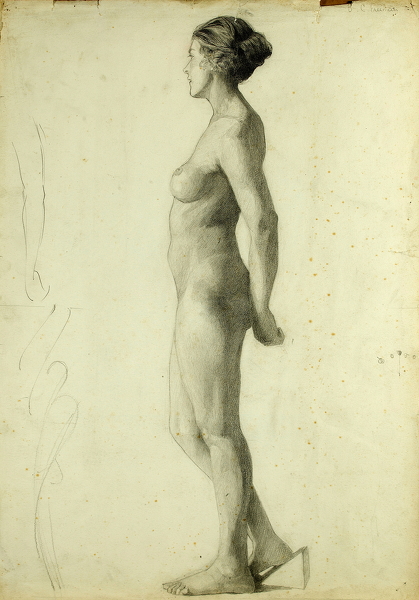
Profile study of nude standing, arms behind her back, right foot raised on a block, circa 1925
Mounted (ref: 4745)
Signed
Pencil, 21 x 10 in. (53.5 x 25.5 cm.)

Signed
Pencil, 21 x 10 in. (53.5 x 25.5 cm.)
Women had historically been discouraged from the nude as a genre,
and even after it became acceptable for women to attend Art School
drawing from a live model, rather than plastercasts, was considered
inappropriate. A measure of the degree to which men felt threatened by
the idea of women painting a nude is demonstrated by the hostile
reaction provoked by Laura Knights iconic Self Portrait (1913), now in
the collection of The National Portrait Gallery, which the Times critic
of the day summed up as 'something dangerously near to vulgarity':
Somehow,
women painting women hardly ever infuses into her work the higher charm
of the ‘eternal feminine’. This painting is obviously but an exercise,
and as such it might quite appropriately have stayed in the artist’s
studio. It repels, not by any special inconvenance – for it is harmless
enough with an element of sensuous attraction – but by dullness and
something dangerously near to vulgarity.
Claude Phillips, The Daily Telegraph, 17 April 1914
Even
favourable press reviews of the time used very condescending language:
Mrs Knights has …proved that she has masculine genius and feminine
courage. Herbert Thomas, Mrs Knights Triumph, The Cornish Telegraph, 26
March 1914, p3.
In Freeman's studies there is an honesty of purpose
that might typically be absent from a nude painted by a man. As Alfred
Lys Baldry observed in Contemporary Figures Painters, The Studio 1925,
this ‘plain matter of fact’ approach to the nudes– ‘the frank fidelity
of the woman artist’ - , shared none of the characteristics of the
‘idealized rendering of the female nude as seen by a male painter ‘
The
source of the above quotes is an article by Pamela Gerrish Nunn, Self
Portrait by Laura Knight, The British Art Journal, volume VIII No. 2 p
53
Barbara Constance Freeman was born on 29 November 1906 in Ealing,
near London. She attended the Tiffin Girls' School in Kingston upon
Thames in Surrey and later studied at the Kingston School of Art.
She
illustrated many books, including The Treasure Hunters by Enid Blyton,
and many collections of fairy tales, both traditional tales by Grimm and
Andersen and modern stories. Some of her earliest illustrations are
found in The Cuckoo Book (1942), a book of fairy tales by Edith Mary
Bell. She also contributed to comics, including Playhour, and to
annuals, such as, Blackie's Children's Annual 1934.
By the 1960s
she had begun writing and illustrating her own books for children and
young adults. Some have a touch of fantasy: in Two-thumb Thomas the
eponymous hero is raised by school cats; in Broom-Adelaide, a fox rides a
flying broomstick. Some, including Lucinda and The Name on the Glass,
are set in the past, while in others, such as A Book by Georgina and The
Other Face, the lives of the main characters are interwoven with
history.
Her artwork is both clean-cut and winsome: an
unmistakable style. Some of her illustrations are still in print as
posters and art prints.
We are grateful to David Buckman for assistance.